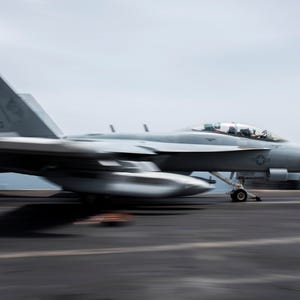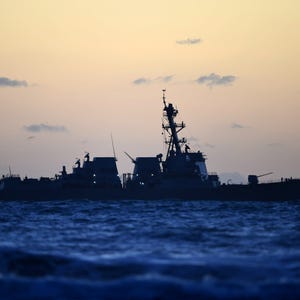Carrier Ike leaves Norfolk to wage war against ISIS
Mark D. Faram, Navy Times
Editor’s note: This article was first published on June 1 at 5:48 p.m. EDT and has been updated.
NORFOLK, Va. — About 7,000 sailors of the Eisenhower Carrier Strike Group departed Naval Station Norfolk Wednesday, bound for the Middle East to join the mounting effort to destroy ISIS.
The deployment of carrier Dwight D. Eisenhower and its escorts is notable for other reasons. It’s the Navy’s first official deployment under the Optimized Fleet Response Plan, which standardizes training and aims to lock-in seven-month deployments. And it kicks off the Atlantic side of the year-long Great Green Fleet expo using alternative fuels and and energy-saving measures.
“The Dwight David Eisenhower Strike Group deploys to relieve the Harry S. Truman Strike Group and will be supporting air strikes against ISIS, answering the nation’s call and stepping up the fight,” said Adm. Phil Davidson, the head of Fleet Forces Command, who was on hand for the send off.
The Ike Strike group is commanded by Rear Adm. Jesse Wilson, a surface warfare officer who took over the group in December as it was beginning to spin up training in preparation for Wednesday’s deployment.
Wilson deflected questions about the carrier swap that took Truman to the Persian Gulf in November — Truman deployed in place of the Ike, which went through a nearly two-year overhaul in Ike’s stead because of extensive repairs the flattop needed — telling reporters that was before his time.
“I took over on 1 December and since then we have been doing nothing but train for this day,” said Wilson, who is the son of a retired master chief petty officer. “Right now, there couldn’t be a more motivated group than the Ike Strike Group.”
The past two carriers in the ISIS fight set ordnance records against ISIS.
On April 17, Truman’s air wing reached the milestone of 580-tons of ordnance dropped in 1,118 pieces during 1,407 sorties, exceeding the weight and numbers dropped by the carrier Theodore Roosevelt during its 2015 deployment.
Asked if his sailors were hoping to surpass the Truman, Wilson said his team’s focus was elsewhere.
“We don’t focus on records,” Wilson said. “We are well trained to drop what needs to be dropped and make it count.”
The Ike CSG’s most pressing mission is to fight terrorists from the sky. But is has also become the East Coast side of the Great Green Fleet initiative. Ike, its air wing and escorts are slated to operate under energy-saving operational procedures during its deployment.
Starting earlier this year on the West Coast, the Great Green Fleet is a year-long operational test to lower energy consumption and showcase alternative fuels that lower U.S. dependence on foreign oil; the Ike CSG, like the Stennis CSG that deployed earlier this year, will be running on a biofuel blend of petroleum and beef fat.
But for the sailors of the strike group, and the loved ones who sent them off on the pier, had in the back of their minds the Optimized Fleet Response plan, which among other features, has promised the stability of seven-month deployments instead of the nearly nine-month cruises in years past, taking a toll on the sailors and the platforms they fight.
Ike leaves Norfolk with the nine squadrons and Carrier Air Wing 3, as well as Destroyer Squadron 26 embarked on board.
Providing escort are the cruisers San Jacinto and Monterey along with the destroyers Mason and Nitze, all of which departed Norfolk today. The destroyer Roosevelt departed Naval Station Mayport, Fla. on Wednesday to join the group; the destroyer Stout is also set to join the Ike CSG.
Back to Top

